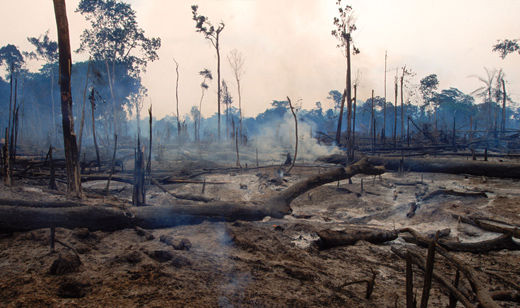
A recent scientific study comparing the role of plants in the sustainability of life on Earth and the current rapid destruction of such life has convinced many scientists that human civilization and well-being will be placed in jeopardy. Rainforests and grass lands around the world are being destroyed at an alarming rate to make room for palm oil plantations, commercial crops of no intrinsic value (tobacco), and the practices of illegal logging for the furniture and lumber trades.
This has led to a massive destruction of the total biomass of the planet all of which is fueled by the immense profits available under capitalism for the private exploitation of natural resources at the expense of sustainable use and of preservation in the interests of environmental conservation for the common good of humanity. The drive for profits is led by major private and state owned capitalist enterprises which, in addition to using the political systems they encounter in many countries to get control of the resources they intend to plunder, also resort to bribery, corruption and other illegal operations in order to attain their ends.
Dr. John Schramski, of the University of Georgia, has recently completed (as lead author) a study of the effects of the overexploitation of Earth’s plant biomass (Science Daily 7/15/15 “Continued destruction of Earth’s plant life places humans in jeopardy”). The rich and diverse animal and plant life of today is the result of several hundred million years of evolution that began when simple one celled organisms developed which were able to chemically change the sunlight they received into useful energy which they could metabolize.
The fact that plants can create their own “food” from sunlight allowed animals to evolve using plants as their source of food: in directly feeding off of the sun. Dr. Schramski used the laws of thermodynamics (the physics of heat in relation to mechanical energy) to calculate the amount of chemical energy the plant world produces and the amount that humanity is at present consuming or destroying via the reduction of forests and other plant environments.
“You can think of the Earth like a battery that has been charged very slowly over billions of years,” he said. “The sun’s energy is stored in plants and fossil fuels, but humans are draining energy much faster than it can be replenished.”
In the last 2,000 years human activity has reduced half of the battery charge (i.e., the biomass accumulated from living carbon over the last several million years). In just the last one hundred years about ten percent of that biomass was wiped out according to the article. This destruction means the Earth has less and less energy to keep the food webs and “biochemical balances” going upon which we all depend.
Dr. Schramski pointed out that, “As the planet becomes less hospitable and more people depend on fewer available energy options, their standard of living and very survival will become increasingly vulnerable to fluctions, such as droughts, disease epidemics and social unrest.”
If humans survive this accelerated loss of biomass Dr. Schramski, and his co-authors (James H.Brown and David Gattie) predict that our species will have to abandon our current civilization and return to hunting and gathering or simple gardening (i.e., a pre-neolithic life style), as populations will crash and large-scale industrial agriculture will be impossible. [Perhaps the world population, after the die off, will be about what it was in 10,000 B.C. or so (one to 10 million people).]
Dr. Schramski says,” I’m not an ardent environmentalist; my training and my scientific work are rooted in thermodynamics. These laws are absolute and incontrovertible; we have a limited amount of biomass energy available on the planet, and once it’s exhausted, there is absolutely nothing to replace it.”
The scientists are hopeful that we can take the drastic measures needed to halt this downward spiral to the paleolithic or extinction. “I call myself a realistic optimist. I’ve gone through these numbers countless times looking for some kind of mitigating factor that suggests we’re wrong,” Dr. Schramski said,” but I haven’t found it.”
One glance at the U.S. Congress should give us an idea where we are headed.
Photo: Human-caused destruction of plant life, as in the rainforest depicted, is a severe threat to the climate, and as a result, the planet. | Rainforest Awareness Worldwide










